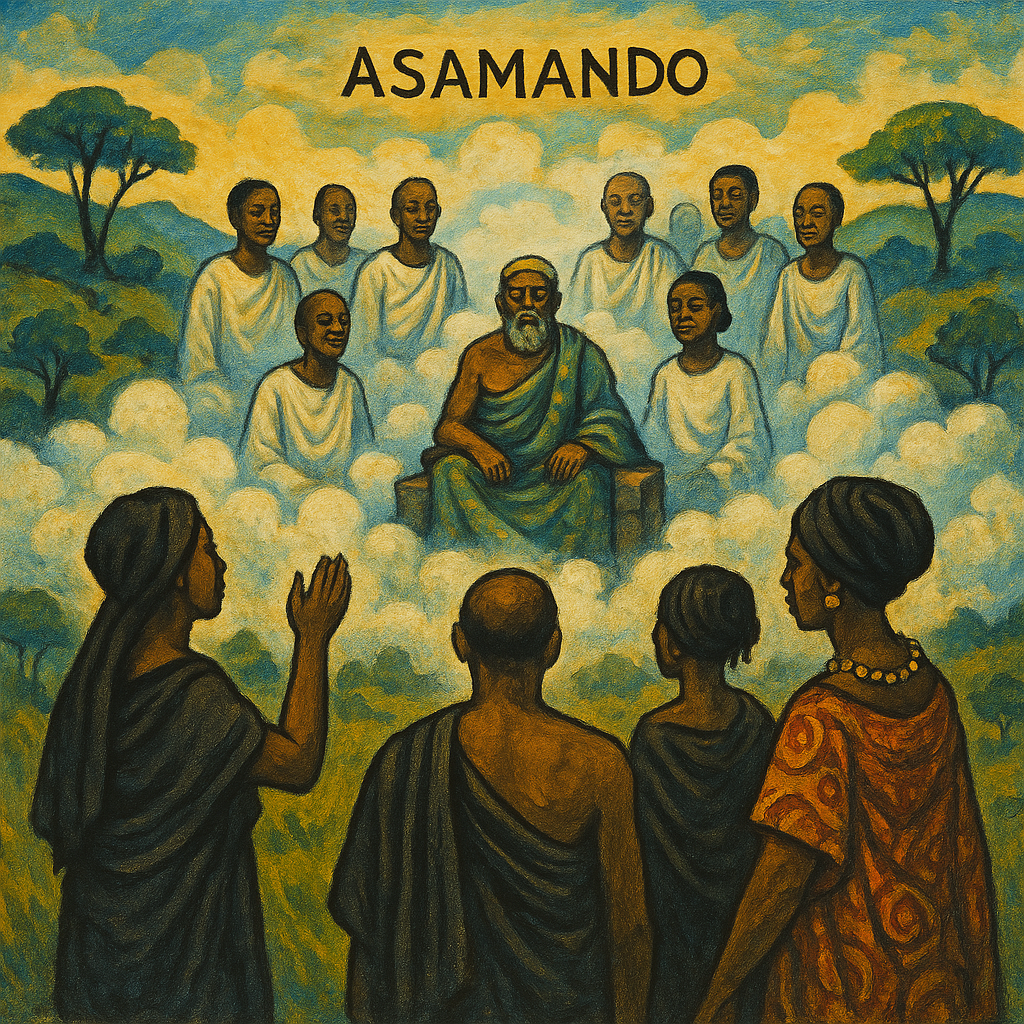Your cart is currently empty!
Asamando (Asaman) – The Spirit Realm in Akan Mythology

Asamando, also spelled Asaman, is the spirit world or ancestral realm in the traditional religion of the Akan people of Ghana, Côte d’Ivoire, and Togo. Deeply embedded in Akan cosmology, Asamando serves as the abode of ancestors (Nsamanfo) and plays a pivotal role in the cycle of life, death, and rebirth. Far from being a place of finality, it is a vibrant spiritual realm, mirroring the societal and familial structures of the living.
Etymology
The name Asamando (or Asaman) derives from the Akan words:
- “Asa” – spirit or departed
- “Man” or “Mando” – land, country, or realm
Together, the term translates to “land of the spirits” or “the country of the dead.” It is sometimes used interchangeably with asamando, asamanso, or asamankese in oral tradition depending on dialect and region.
Location and Nature
Asamando is believed to exist parallel to the physical world. It is not located in the sky or under the earth in a literal sense, but rather in a spiritual dimension that the living cannot access except through ritual, dreams, or spirit communication. The geography of Asamando reflects the Akan understanding of order, clan, and lineage, organized similarly to earthly villages, towns, and chieftaincies.
The entrance to Asamando is a sacred passage the soul journeys through upon death. This transition is highly ritualized to ensure the peaceful arrival of the spirit.
Inhabitants of Asamando
1. Nsamanfo (Ancestors)
These are the righteous dead, individuals who died honorable deaths, fulfilled their societal duties, and received proper funerary rites. They retain their personalities, names, and roles, often continuing to serve their families from the spirit world.
2. Abosom and Nature Spirits
While distinct from the gods (abosom), some divine beings also traverse Asamando, especially those connected to nature and the underworld, such as Epo (spirit of the sea) and Asase Yaa (Earth goddess).
3. Lost or Dishonored Spirits
Spirits who died tragically, were not buried properly, or led dishonorable lives may become restless or malevolent. These include:
- Sasabonsam: dangerous forest spirits sometimes associated with the unquiet dead.
- Efun: wandering ghosts.
- Mmoatia: dwarf spirits who can be tricksters or guides.
Functions of Asamando
1. Continuation of Life
Asamando is not an end but a continuation of the individual’s existence. The soul (kra) lives on, interacts with the living, and may be reborn into the family lineage.
2. Ancestral Intercession
Ancestors act as intercessors between the living and Nyame, the Supreme God. They guide, protect, and influence the fate of their descendants. People offer libations, sacrifices, and prayers to honor them.
3. Moral and Social Order
The concept of Asamando reinforces communal values, respect for elders, and the importance of legacy. One’s behavior in life directly affects one’s status and peace in Asamando.
Access to Asamando
1. Death and Rites
When a person dies, the soul (kra) begins its journey to Asamando. The path is eased by:
- Elaborate funerals
- Mourning rituals
- Final cleansing rites (to sever ties with the physical world)
Without these, the soul may become stuck or return as a ghost.
2. Communication with the Dead
The boundary between the living and Asamando is thin. Ancestors often appear in:
- Dreams
- Trance states
- Ritual possession
- Divination (Akom)
Communication is frequent during Akwasidae (ancestor festival days held every 6 weeks), where families pour libations and seek blessings.
Social Structure in Asamando
Asamando reflects a hierarchical society, organized much like Akan communities:
- Family lineages (abusua)
- Clan heads
- Elders
- Ancestral chiefs (Nananom Nsamanfo)
In some traditions, the realm is governed by a spiritual chief called Nana Asaman or Asamankesehene. Leadership and respect among spirits are maintained as they were in life.
Cosmic Cycle and Rebirth
The Akan believe in reincarnation (called nkrabea or destiny). A soul may:
- Remain in Asamando
- Be reborn into its family line, often marked by shared traits or birth circumstances
- Be consulted via naming ceremonies or divination to identify returning ancestors
As such, a child may be recognized as the reincarnation of a grandmother, and the cyclical nature of existence is honored.
Asamando vs. Western Afterlife Concepts
| Feature | Asamando | Western Heaven/Hell |
|---|---|---|
| Judgement | Based on social harmony, not sin | Based on moral/religious judgment |
| Location | Parallel spiritual realm | Typically above or below earth |
| Purpose | Continuation of life and lineage | Final reward/punishment |
| Interaction | Regular ancestor communication | Rare or forbidden |
| Rebirth | Common | Rare or absent |
Modern Relevance
Even among Christian or Muslim Akans, belief in Asamando endures, often syncretized with new religious practices. Many still:
- Consult ancestors
- Perform libations
- Observe family rituals during Akwasidae
It remains a core of Akan identity, cultural memory, and spirituality.
In Literature and Art
Asamando appears in:
- Akan folktales about ghosts and ancestor spirits
- Adinkra symbols, especially those related to life, death, and continuity
- Oral poetry and songs praising Nsamanfo
- Funerary art, coffin designs, and memorial sculptures
See Also
- Nsamanfo – Ancestors in Akan culture
- Akwasidae – Festival of the ancestors
- Nyame – Supreme God in Akan religion
- Asase Yaa – Earth goddess and embodiment of morality
- Mmoatia – Dwarf forest spirits
- Kra – The soul or life-force
- Abusua – Matrilineal clan system
Leave a Reply